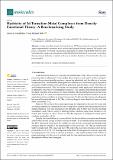Files in this item
Hydricity Of 3d transition metal complexes from density functional theory : a benchmarking study
Item metadata
| dc.contributor.author | Goodfellow, Alister Stewart | |
| dc.contributor.author | Buehl, Michael | |
| dc.date.accessioned | 2021-07-05T11:30:12Z | |
| dc.date.available | 2021-07-05T11:30:12Z | |
| dc.date.issued | 2021-07-03 | |
| dc.identifier | 274866339 | |
| dc.identifier | d5c2c9e9-6ca9-434a-82b6-37ec949478c2 | |
| dc.identifier | 000671113000001 | |
| dc.identifier | 85110128920 | |
| dc.identifier.citation | Goodfellow , A S & Buehl , M 2021 , ' Hydricity Of 3d transition metal complexes from density functional theory : a benchmarking study ' , Molecules , vol. 26 , no. 13 , 4072 . https://doi.org/10.3390/molecules26134072 | en |
| dc.identifier.issn | 1420-3049 | |
| dc.identifier.other | ORCID: /0000-0002-1095-7143/work/96817293 | |
| dc.identifier.uri | https://hdl.handle.net/10023/23468 | |
| dc.description.abstract | A range of modern density functional theory (DFT) functionals have been benchmarked against experimentally determined metal hydride bond strengths for three first-row TM hydride complexes. Geometries were found to be produced sufficiently accurately with RI-BP86-D3(PCM)/def2-SVP and further single-point calculations with PBE0-D3(PCM)/def2-TZVP were found to reproduce the experimental hydricity accurately, with a mean absolute deviation of 1.4 kcal/mol for the complexes studied. | |
| dc.format.extent | 13 | |
| dc.format.extent | 863560 | |
| dc.language.iso | eng | |
| dc.relation.ispartof | Molecules | en |
| dc.subject | DFT | en |
| dc.subject | 3d metal complex | en |
| dc.subject | Benchmark | en |
| dc.subject | Hydricity | en |
| dc.subject | QD Chemistry | en |
| dc.subject | DAS | en |
| dc.subject.lcc | QD | en |
| dc.title | Hydricity Of 3d transition metal complexes from density functional theory : a benchmarking study | en |
| dc.type | Journal article | en |
| dc.contributor.institution | University of St Andrews. EaSTCHEM | en |
| dc.contributor.institution | University of St Andrews. School of Chemistry | en |
| dc.identifier.doi | https://doi.org/10.3390/molecules26134072 | |
| dc.description.status | Peer reviewed | en |
| dc.identifier.url | https://www.mdpi.com/journal/molecules/special_issues/Alexandra_Slawin | en |
This item appears in the following Collection(s)
Items in the St Andrews Research Repository are protected by copyright, with all rights reserved, unless otherwise indicated.

